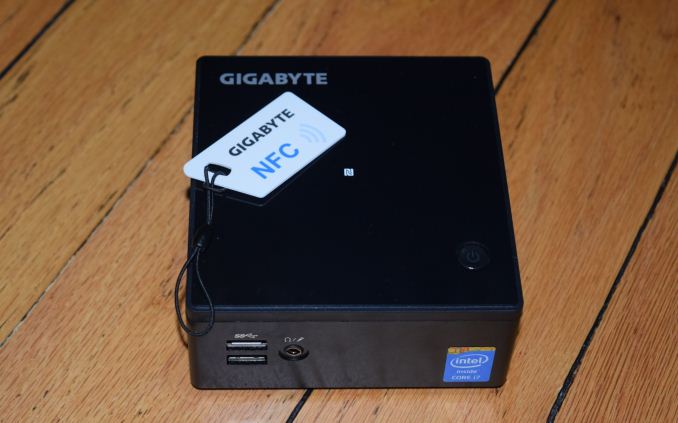GIGABYTE GB-BXi7H-5500 Broadwell BRIX Review
by Ganesh T S on January 29, 2015 7:00 AM ESTFinal Words
The GIGABYTE GB-BXi7H-5500 provided us with the opportunity to take a look at what Broadwell-U can deliver. The migration from 22nm to 14nm has allowed for higher base clocks while maintaining the same power envelop. The performance delta over the Haswell-U-based GB-BXi7-4500 (particularly, on the graphics side) is notable. That said, while migrating from Sandy Bridge or Ivy Bridge is a no-brainer, there is not enough on offer to recommend migrating from a Haswell-based mini-PC.
From the perspective of the BRIX itself, the GB-BXi7H-5500 has two major downsides, and both of them are related to the networking subsystem. Considering that the i7 SKU is the 'premium' SKU in this lineup, use of a 1x1 802.11ac (Intel AC3160) card is disappointing. It would have been nice to have the AC7260 or AC7265. The Broadcom BCM4352 is even more preferable. In addition, GIGABYTE should have opted for an Intel LAN chipset instead of a Realtek one for this high-end configuration.
One of the interesting differentiating features is the availability of NFC. Along with the unit, GIGABYTE also supplied a NFC tag. The accompanying driver DVD has a NFC app (Windows program) which allows creation of profiles to link with the tag. These profiles could be associated with web addresses or files / programs in the system. Tapping the tag against the unit's lid activates the profile. Right now, this is a basic application. GIGABYTE indicated that they are working on bringing more functionality to the app and making it easier to use.
The pricing of the Core i7-5500U makes it attractive for high-end ultrabooks, but the BXi7H-5500 manages to get it to the consumer in a UCFF PC at a reasonable price ($509, when Intel apparently sells the CPU alone for $393). All in all, GIGABYTE has managed to deliver the right balance of price, power, size and thermal / acoustic design in the GB-BXi7H-5500. It remains to be seen what Intel is able to offer with the NUC lineup and how the NUCs will complement and/or compete against the Broadwell BRIX units.











53 Comments
View All Comments
voicequal - Saturday, February 7, 2015 - link
The frequency and temperature characteristics are the most interesting and uniquely Anandtech parts of these reviews. Please keep up the good work.I'm puzzled as to how a CPU with a base clock specification of 2.4 GHz can drop to 1.6 GHz during the CPU+GPU loading test? Doesn't that make the base clock effectively 1.6 GHz at the given TDP of 15W?
It's disconcerting that the GPU can steal power from the CPU, and yet this doesn't show up anywhere on the spec sheet but is continually exposed by these reviews.
xchaotic - Monday, February 16, 2015 - link
Actually for the most obvious scenarios I can think of - gaming and other GPU accelerated tasks, I think it's better to give GPU priority, but I think there should be a software option to control how this works, along with other power saving features like idle timers...I can think of scenarios where both the CPU and GPU are loaded and the CPU should be given priority...
BtotheT - Monday, March 30, 2015 - link
I'm thinking the next big leap for Brix will be the Skylake H series processors(Q4'15-Q2'16). The Broadwell model here was a dual core, with non edram graphics(HD5500 series no less, Broadwell's low end) , you can't expect it to keep up with a quad core with edram the 4770R had.